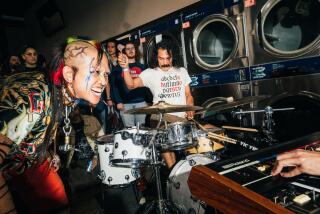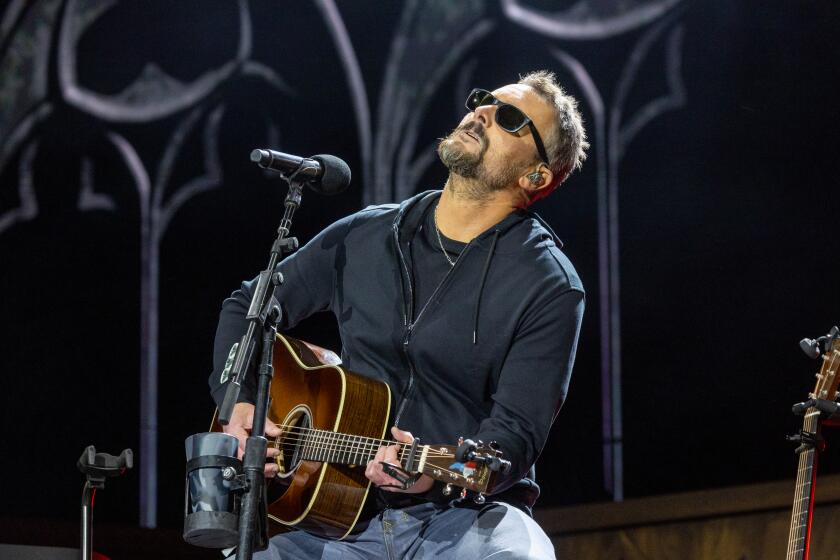The L.A. DIY community contemplates a post-Ghost Ship life
After a December fire in Oakland killed dozens of young music fans at the DIY venue known as Ghost Ship, one question has ricocheted around L.A.’s underground music community: What do we do now?
In the wake of tragedy and public scrutiny, L.A.’s underground promoters, artists and fans know that change is coming. A scene that felt like a little utopia has been scarred by unbelievable loss, and a police crackdown on un-permitted venues has already begun (the popular Burning Man hangout Purple 33, near Culver City, was among the first to go).
Long-simmering fears of displacement — over safety concerns and gentrification alike — have proven prescient.
The conversation about how to move forward has been difficult to document. Many in the scene have, out of fear for their livelihoods, retreated deeper into the underground, relying on private social-media groups, specialized apps and a no-talking-to-media policy to avoid further pressure.
Yet few promoters seem ready to give up. Many consider such shows to be safe havens for marginalized groups not welcome at more mainstream venues. Additionally, as scared and frustrated as some promoters are, others are optimistic that a safer future is possible and argue for open dialogue among underground promoters, city officials and cultural institutions.
To see how they were adapting to the new, post-Ghost Ship reality, The Times reached out to several dozen promoters and artists involved in L.A.’s underground club-music scene. Although the response from many was silence, others conveyed a need to publicly defend the importance of underground music culture.
“Look at the Bauhaus parties in the ’20s, look at Shakespeare and Andy Warhol. Think of our most profound artists in history: These are the spaces where they come from,” said Derek Marshall, who throws the underground, LGBT-focused roving party Ostbahnhof. “If you want to have a thriving culture, these spaces need to be protected. It’s not about going to get messed up or disassociate, it’s about creating beauty and making the world a better place. ”
The response of the many promoters who politely declined to comment was typified by one who said, “My gut reaction is that I think I need to lay low on this.”
Some cited a recent L.A. Times article in which reporters visited underground shows and published names of promoters who didn’t always have the necessary permits. Others said that media scrutiny blamed the very people who perished at Ghost Ship for creating the conditions that killed them.
But a few concert promoters have decided to speak out — to demystify what they do and rebut stereotypes about the scene. They hope that the Ghost Ship tragedy might open up new relationships with local governments and institutions, to find a détente that allows for DIY shows with a renewed transparency about safety.
The promoters who spoke to The Times emphasized that they would pursue any opportunity to improve safety at their shows. The conditions at Ghost Ship were, if not completely anomalous, some of the worst in the DIY world. The Oakland fire department had no records of visits to the building in 12 years, and building code inspectors hadn’t visited in 30. The space was full of combustible, exit-blocking furniture, and many of the dead were trapped above an illegal stairway built from wooden pallets.
“If you don’t think about the basic safety of your guests then you’re doing it wrong,” said Aaron Davis, the promoter behind the popular Acid Camp series of concerts and daytime parties. “There are simple things, like multiple easily accessible exits, that I always make sure are obstacle-free. Many times, ‘DIY’ still means up to code and beyond. Many people can’t afford to pull permits but can still have an A+ safety rating.”
After Ghost Ship, a popular public Google document made the rounds in clubland offering tips for abiding by safety codes in DIY venues. But the process of navigating building and fire codes, coupled with the expense of pulling event permits, as well as producing the actual shows, can be opaque and often economically unfeasible for small-scale concerts.
When reached for comment on Wednesday, representatives for the Los Angeles Fire Department said they would be unable to answer questions by press time.
In Berlin, perhaps the city with the most successful nightlife scene on the planet, there is an intermediary to help promoters abide by the best safety practices. Lutz Leichsenring is the spokesman for Berlin’s Clubcommission, a group designed as a liaison between Berlin’s artistic communities and its governing bodies. Other cities like London and Amsterdam have similar agencies.
While Berlin has a famously liberal attitude toward clubbing (especially compared to California’s 2 a.m. closing times and cost-prohibitive liquor licensing), Leichsenring sees his group as model for how to organize a sometimes-unruly artistic scene, advocate for its cultural and economic merits, and better communicate with local governments.
As L.A. reckons with Ghost Ship and how to regulate such venues, a similar advocacy body might be advantageous.
“I think what needs to be done is to create understanding on both sides,” Leichsenring said. “Our strategy was to create a platform for young promoters. At our second meeting, we invited a lawyer to explain to them exactly what is legal and illegal, and also the gray zones. The next meeting was to talk to politicians, and they said, ‘We understand this is something Berlin needs, but there are problems. If you find solutions to this, we will support you.’”
“The police don’t want to spend their time shutting down parties,” he added. “The police were some of the first allies we got, actually. ”
That dialogue can create literal dividends for cities. Berlin-based tech companies like Soundcloud, Ableton and Native Instruments all have direct roots in the city’s vibrant electronic music scene.
Another strategy might be closer partnerships with existing cultural institutions, like MOCA and the Broad Museum, whose vast fiscal and political capital could create opportunities for struggling promoters while maintaining artistic credibility.
Many of the marquee cultural spaces in L.A. host underground music performances on-site, such as the Music Center’s popular Sleepless after-hours series and the Broad’s Nonobject(ive) concerts, which have featured experimental acts like Sophie, Elysia Crampton and Lotic.
Some hope that such institutional muscle could someday fund off-site programming as well.
“It’s interesting to see in other major cities how museums have grounding connections to the underground,” said Nacho Nava, the promoter for the long-running, gay-focused, experimental club night Mustache Mondays, now held at the (fully permitted) downtown bar the Lash. L.A., he argued, is just starting to bridge the worlds of high art and underground dance music.
“It’s important to remember this when speaking on the state of nightlife in Los Angeles,” Nava said. “It’s vital for artists to talk, work together and exchange ideas.”
Another source of strength could be a re-emphasis on the social-justice elements of nightlife. Many of the leading underground parties are explicitly centered around LGBT identity and music originating from marginalized groups. While many welcome mixed crowds, much of their audience goes to underground shows for the rare freedom from violence or harassment.
In our reactionary political environment, these parties can be necessary refuges and resources for organizing. Well-connected LGBT activist groups could potentially help support underground shows post-Ghost Ship, where many of the dead were gay and trans youth.
“When I was throwing parties in New York in [more mainstream] nightclubs, I’d get e-mails from people in the queer community who felt unsafe, that there was a lot of gawking. Mainstream clubs can attract a certain clientele that just makes people feel unsafe if you dress in drag or if you’re trans,” Marshall said.
“And it’s a class thing as well. In the underground spaces you have a lot of folks who just don’t have a lot of money. When you go out in WeHo, there’s a commercial viability that just doesn’t exist here.”
In the end, the future of L.A.’s underground music scene probably will depend on some sort of political organizing. Ostbahnhof’s Marshall has worked for a Berlin NGO supporting the United Nations and is currently communications director for Jessica Salans, a candidate running for Los Angeles City Council in District 13.
For him, that political experience underlined the potential for L.A.’s nightlife scenes to productively engage with the city and not retreat into the underground. His work has convinced him that politicians will listen and act on their concerns.
After Ghost Ship, Oakland’s mayor announced a $1.7-million fund to aid artists displaced by gentrification, which many in the scene blamed in part for the cramped, neglected conditions there.
“Anything that’s worth fighting for needs to happen in the public eye,” Acid Camp’s Davis said. “You need people to see that you’re fighting for something better. Our fight is for safer, non-discriminating and welcoming events and parties.”
Structural safety has to be part of that conversation, of course. But for promoters who wish to engage with the city on safety, it’s hard to argue that they should not also be met with a promise from local governments to keep their own culture vital as well.
“I hope that we will cherish and invest in the local arts more, and create safer spaces for all types of arts and events,” Davis said. “No one should have to risk their life to enjoy what they love.”
ALSO
Trump’s pre-inaugural concert projected a troublingly narrow vision of America
‘No, take me seriously’: Meet the Regrettes and Cherry Glazerr, L.A.’s new faces of rock
Arcade Fire and Mavis Staples try to lift spirits with ‘I Give You Power’
More to Read
The biggest entertainment stories
Get our big stories about Hollywood, film, television, music, arts, culture and more right in your inbox as soon as they publish.
You may occasionally receive promotional content from the Los Angeles Times.







